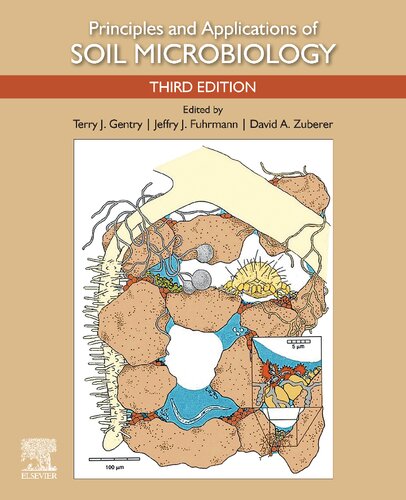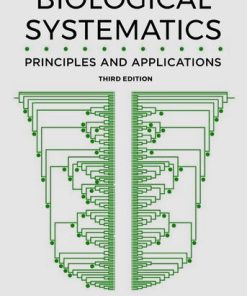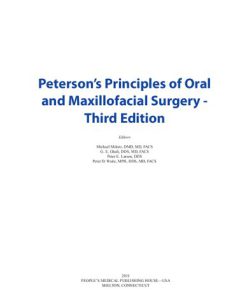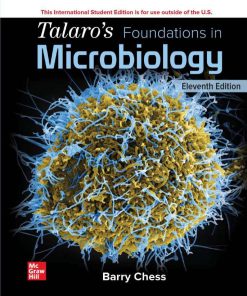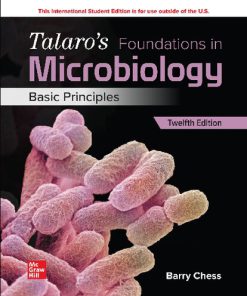Principles and Applications of Soil Microbiology 3rd Edition by Terry Gentry, Jeffry Fuhrmann, David Zuberer ISBN 0323851401 9780323851404
$50.00 Original price was: $50.00.$25.00Current price is: $25.00.
Principles and Applications of Soil Microbiology 3rd Edition by Terry J. Gentry, Jeffry J. Fuhrmann, David A. Zuberer – Ebook PDF Instant Download/Delivery: 0323851401, 978-0323851404
Full dowload Principles and Applications of Soil Microbiology 3rd Edition after payment
Product details:
ISBN 10: 0323851401
ISBN 13: 978-0323851404
Author: Terry J. Gentry, Jeffry J. Fuhrmann, David A. Zuberer
Principles and Applications of Soil Microbiology 3rd Edition:
Written by leading experts in their respective fields, Principles and Applications of Soil Microbiology 3e, provides a comprehensive, balanced introduction to soil microbiology, and captures the rapid advances in the field such as recent discoveries regarding habitats and organisms, microbially mediated transformations, and applied environmental topics. Carefully edited for ease of reading, it aids users by providing an excellent multi-authored reference, the type of book that is continually used in the field. Background information is provided in the first part of the book for ease of comprehension. The following chapters then describe such fundamental topics as soil environment and microbial processes, microbial groups and their interactions, and thoroughly addresses critical nutrient cycles and important environmental and agricultural applications.
An excellent textbook and desk reference, Principles and Applications of Soil Microbiology, 3e, provides readers with broad, foundational coverage of the vast array of microorganisms that live in soil and the major biogeochemical processes they control. Soil scientists, environmental scientists, and others, including soil health and conservation specialists, will find this material invaluable for understanding the amazingly diverse world of soil microbiology, managing agricultural and environmental systems, and formulating environmental policy.
- Includes discussion of major microbial methods, embedded within topical chapters
- Includes information boxes and case studies throughout the text to illustrate major concepts and connect fundamental knowledge with potential applications
- Study questions at the end of each chapter allow readers to evaluate their understanding of the materials
Principles and Applications of Soil Microbiology 3rd Edition Table of contents:
Chapter 1: Introduction and Historical Perspective
- Soil habitat
- Nature of cellular organisms
- Historical context of soil microbiology
Chapter 2: The Soil Habitat
- Soil description
- Soil components
- Soil environment
- Integrating soil properties and plants with microorganisms: the rhizosphere
Chapter 3: Microbial Metabolism
- An overview of microbial metabolism
- Chemical foundations of metabolism
- Role of enzymes in metabolism
- Production of ATP
- Glycolysis
- Fermentation
- Respiration
- Phototrophy
- Carbon nutrition
- Integration of metabolic pathways
Chapter 4: Microbial Genetics
- Nucleic acids: DNA and RNA
- Cellular nucleic acid processes
- In vitro nucleic acid processes
- Applications of genetic methods in soil ecosystems
Chapter 5: Bacteria and Archaea
- Biology of bacteria and archaea
- Nutritional strategies
- Linking bacteria and archaea to soil
- Quantifying bacterial populations
Chapter 6: Fungi
- Cell structure and function
- Growth and nutrition
- Genetics, survival, and dispersal
- Ecology
Chapter 7: Cyanobacteria and Algae
- Classification
- Soil algal morphology and reproduction
- Physiology and ecology of algae and cyanobacteria in soil
Chapter 8: The Soil Fauna
- Habitat and functional groups of soil fauna
- Soil food web context
Chapter 9: Viruses
- Virus particle and genome structure
- Viral replication
- Measuring viral abundance and diversity in soils
- Viruses by host
Chapter 10: Microbial Ecology
- Soil organisms and their interactions
- Soil food web: producers and consumers
- Growth characteristics of soil microorganisms
- Interactions between organisms and soil
- Microbial succession
- Measurement of microbial diversity and interactions
Chapter 11: Rhizosphere
- The root environment
- Rhizosphere boundaries and environment
- Genetically modified organisms
- Plant-derived compounds
- Organisms inhabiting the rhizosphere
- Microbe-plant interactions
- Inoculants
- Modeling rhizosphere function
Chapter 12: Mycorrhizal Symbioses
- Global perspective
- Mycorrhizal types
- Biomass and community profiling
- Features of symbiosis
- Biotechnological applications
Chapter 13: Carbon Transformations and Soil Organic Matter Formation
- Terrestrial carbon cycle
- Microbial role in carbon cycling
- Decomposition of organic materials
- Soil organic matter (SOM)
Chapter 14: Applied Aspects of Soil Carbon
- Soil carbon management
- Tillage and organic amendments
- Biofuel crop residue management
- Carbon sequestration
- Soil health
Chapter 15: Transformations of Nitrogen
- Nitrogen cycle
- Transformations between organic and inorganic forms
- Oxidative and reductive processes
Chapter 16: Biological Dinitrogen (N2) Fixation: Introduction and Nonsymbiotic
- Historical background
- Significance of biological N2 fixation
- Free-living nitrogen-fixing bacteria
- Factors affecting dinitrogen fixation by free-living diazotrophs
- N2 fixation by plant-associated bacteria: the associative symbioses
Chapter 17: Biological Dinitrogen Fixation: Symbiotic
- The symbiosis between legumes and rhizobia
- The infection process
- Environmental factors affecting symbiosis in legumes
- Legume inoculation
- Frankia and the actinorhizal symbiosis
Chapter 18: Microbial Transformations of Sulfur in Soil
- Sulfur cycle in agroecosystems and terrestrial environments
- Microbial transformations of sulfur
- Microbial oxidation and reduction of sulfur compounds
- Volatilization of sulfur compounds from soil
- Environmental aspects of sulfur pollutants
Chapter 19: Phosphorus and Selected Metals and Metalloids
- Phosphorus
- Iron, manganese, mercury, selenium, and arsenic
- Microorganisms as catalysts for mineral formation
Chapter 20: Global Gases
- Defining trace gases
- Importance of global gases
- Gases released from soils
- General controls on trace gas production
- Carbon-based and nitrogen-based gases
Chapter 21: Biodegradation of Environmental Pollutants
- Biological processes
- Ecological factors
Chapter 22: Bioremediation of Contaminated Soils
- Sources of contamination
- Common soil contaminants
- Human and environmental risks
- Magnitude of the problem
- General approaches to bioremediation
- Advantages and disadvantages of bioremediation
- Practical considerations for selecting bioremediation
- Case studies
Chapter 23: Biological Control of Soilborne Plant Pathogens and Nematodes
- Fundamental biological control concepts
- Plant-soil-microbial equilibrium
- Biological control with resident antagonists
- Rhizobacteria
- Commercialization of biological control agents
Chapter 24: Composting: The Microbiological Processing of Organic Wastes
- Compost microbiology
- Stages in the composting process
- Raw materials for composting
- Compost inoculants
- Other organic soil amendments
Chapter 25: Soil Microbial Influences on “One Health”
- What is “One Health?”
- Influence of microbes on soil health
- Quantification of soil health via microbial activity
- Influence on plant, animal, and human health
People also search for Principles and Applications of Soil Microbiology 3rd Edition:
what is the principle of microbiology
what is microbiology and its applications
soil microbiology ecology and biochemistry
microbiology in soil
microscope soil analysis
Tags:
Terry Gentry,Jeffry Fuhrmann,David Zuberer,Principles,Applications,Soil,Microbiology
You may also like…
Biology and other natural sciences - Biology
Biological Systematics Principles and Applications 3rd Edition Andrew V. Z. Brower
Biology and other natural sciences - Microbiology
Religion & Spirituality - Christianity
God s Kingdom through God s Covenants 2nd Edition Peter J Gentry Stephen J Wellum
Biology and other natural sciences - Biology
Oral Biology Molecular Techniques and Applications 3rd Edition Gregory J. Seymour
Biology and other natural sciences - Microbiology
Medicine - Molecular Medicine
Molecular Imaging Basic Principles and Applications in Biomedical Research 3rd Edition Markus Rudin
Mathematics - Geometry and Topology

